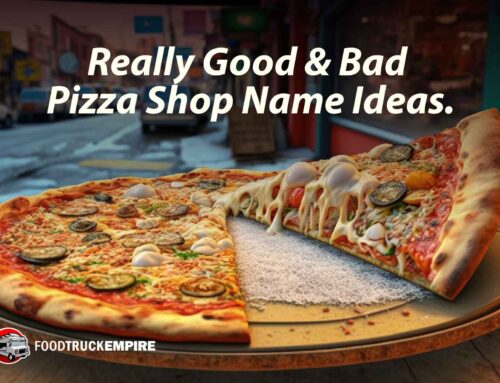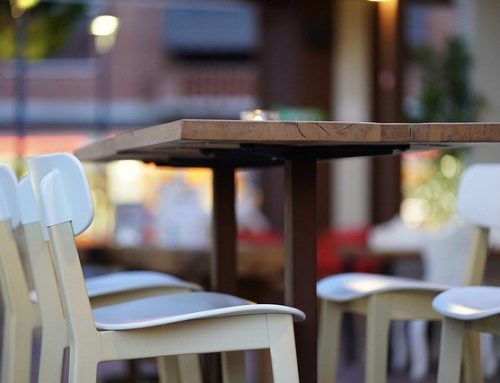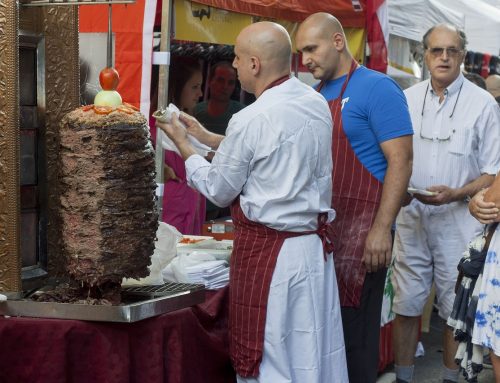After a few years toiling away in the sweltering hot, confined space of an 8×10 concession trailer, and enjoying a fair amount of press and accolades, the time seemed right to make the leap into a brick-and-mortar restaurant.
There was just one problem: With a lousy credit score and credit cards that had been stretched to the breaking point keeping the food truck afloat, I was flat broke and hardly an attractive prospect for potential investors. So, like most of our dedicated Food Truck Empire readers, I did what came naturally: I got my hustle on and made it happen, anyway.
I’ll detail the process by which I converted an old farmhouse in Maine into Ancho Honey, a fully licensed commercial restaurant in another post, but for now, I wanted to focus on one key idea that every entrepreneur can use to generate a little bit of extra startup revenue, for getting their dream project off the ground, whether it’s a food truck, a cafe, or a full-scale restaurant: T-shirts.
Why Every Food Business Startup Should Consider T-Shirt Sales
Wait, t-shirts? Like, those throwaway items that are already cluttering up closets nationwide? Yes, t-shirts can help you build your brand, create buzz, flex your creative muscles, build community, and bring in the money needed to get you over those final hurdles…and all without spending a dime.
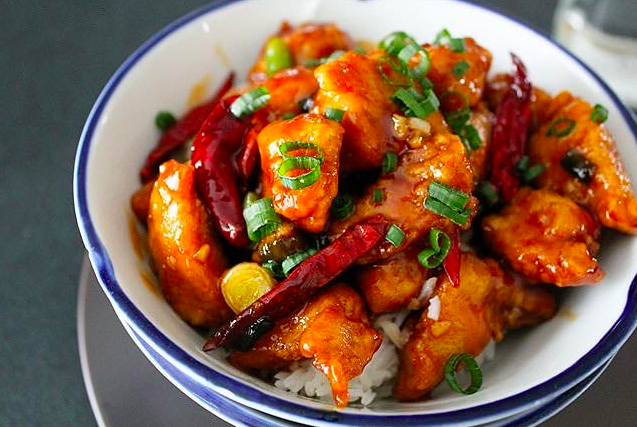
Print-on-Demand Versus Bulk Ordering
Before we get too far down this t-shirt marketing wormhole, let’s talk about the difference between print-on-demand services, and placing bulk t-shirt orders for hundreds of shirts yourself.
There are dozens of websites, such as Teespring, where users can create and sell t-shirts online without any overhead or startup fees. The process is simple: Settle on your design, upload it to the print-on-demand service of your choice, choose the apparel you’d like it printed on, set your price, and then stand back and let the print-on-demand service handle manufacturing and fulfillment, all at no up-front cost to you.
Most of these sites will quote you a base price for your finished design, which you can then mark up as much as you’d like; for example, if your cost per shirt is $10.55, and you choose to sell them for $18, that’s $7.45 out of each sale directly in your pocket…with no upfront cost to you.
What’s the downside to print-on-demand? First, you usually don’t get to check on the quality of your finished items, without buying one yourself. And the quality with many of these services is all over the map, so you’ll want to do a test order.
Second, you don’t get to control any of the marketing for the customer you’ve helped acquire; sell shirts yourself, and you capture all of the data about your customer, who you can then email additional promotions, opening announcements, etc.
Finally, if your volume is low, the margins aren’t usually as good with a print-on-demand fulfillment service. Order t-shirts in bulk and take on the cost and risk yourself, and you can find prices as low as $4 dollars per shirt.
Companies like CustomInk specialize in these types of bulk purchases, and we endorse their service wholeheartedly. Many of their items have no minimums, which means you can order shirts yourself, handle all of the fulfillment…and pay for the shirts out-of-pocket. For most of us, this kind of up-front investment is out of the question.
If you’re starting to do the math in your head about whether or not selling t-shirts is worthwhile for your, here’s a quick t-shirt profit analysis you can use to use to estimate what you could make selling swag like this at your establishment. This chart assumes you’ve selected a vendor like Teespring above where you don’t need to invest any money up front. This will lower your net profit per shirt as described above, but also remove any risk in the event no one likes your designs. You also won’t need to worry about investing in a whole bunch of different sizes, which can be costly.
| Cost-Per Shirt | Number of Shirts Sold | Gross Sales Retail | Net Profit (Before Tax) |
| $10.55 | 1 | $18 | $7.45 |
| $10.55 | 5 | $52.75 | $37.25 |
| $10.55 | 10 | $105.50 | $74.50 |
| $10.55 | 25 | $263.75 | $186.25 |
| $10.55 | 50 | $512.50 | $372.50 |
| $10.55 | 100 | $1,055.00 | $745.00 |
As you can see, if you are able to sell 2 – 4 of these t-shirts per day it can significantly impact in the bottom line at the end of the month. Don’t forget to factor in that anyone wearing your clothes in the future becomes a walking build board for your restaurant. More on this below.

T-Shirts Help Build Community Loyalty and Brand Awareness, Before You’ve Cooked a Thing
One of the trickiest things for any new business to generate is conversation about their new brand, particularly before the doors are open and there’s any product for customers to try.
Selling t-shirts allows potential customers, supporters, and community members to share your message with the world, while showing their support for your project.
T-Shirts are Social Media Food
You may make the most incredible breakfast sandwiches on the planet. So you’ve started your marketing early; you’ve purchased DankBrekkies dot com*, locked down your Instagram, Twitter, and Facebook accounts, and are ready to start sharing your creations with the world. But the problem is, until you’re actually open, what do you talk about on your social media channels?
*Please don’t name your breakfast sandwich place “Dank Brekkies.” Or if you do, please direct all future royalty payments to Malcolm Bedell, c/o Food Truck Empire.

Open a t-shirt storefront, and you’ve instantly got something to talk about with your fledgling community. In addition to (constantly!) hawking your latest designs, invite fans and customers to submit photos of themselves in their new branded t-shirts.
For Ancho Honey, we rolled out a new design once per week, and posted user submitted photos from anyone that bought a shirt. If sales were slow for a particular design, we used a t-shirt mockup generator like PlaceIt.net for low-cost, professional images featuring our design, while we waited for customer photos to roll in.
The benefits of this are twofold. First, there’s the obvious revenue component. But you’re also already building a community of like-minded, in-the-know customers who are going to start sharing your brand and talking about it with others…before Dank Brekkies has slung its first first bacon, egg, and cheese sandwich.
The Design Process
There are many ways to start transitioning your food business idea from a hare-brained brainstorm, into a real-life business. Many experts will tell you that ironing out a rock-solid business plan, complete with market analysis, potential pitfalls, and sales projections is the best way to start.
This is good advice, but it’s also not the way my brain works; for me, I start noodling around with names, logos, and menu ideas, long before I’ve done the research to find out if my idea makes sense.

Face it: When your idea has a logo, it’s a real thing, because real things have logos. Designing the look of your potential new business helps solidify your idea in your mind, and helps you define many of the aspects of your look and feel. Of course, along the way, you’ll come up with a bunch of ideas that you’ll discard…and those can be outstanding t-shirt designs.
For example, my restaurant, Ancho Honey, is located in a sleepy, seaside residential community in New England, so I wanted to come up with a logo that would feel sophisticated, and fit in with its environment.
But I’m also a food truck guy at heart, so I really wanted to put a retro screaming panther with lightning bolts on my signage. While the “Lightning Panther” wasn’t a good fit for the actual business, it was perfect for a t-shirt, and created a fun, limited edition collectible for a business that didn’t exist yet.
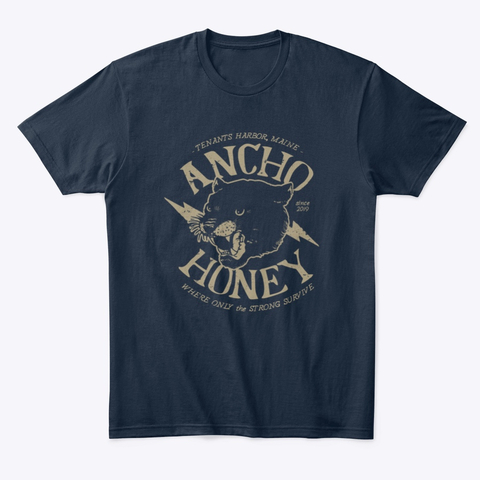
When dreaming up t-shirt designs, don’t be afraid to have some fun. You can get away with t-shirt designs that you’d never try in real life, and the more designs you can come up with, the likelier you are to find potential customers.
Pricing Your Creations for Maximum Revenue
If you’ve done some quick math, you’ve probably realized that at only $3 or $4 bucks in profit per item sold, you’d have to sell an awful lot of t-shirts to generate any kind of meaningful revenue. My advice for this is simple: Make more than that.
Everyone has a “comfort zone” when deciding whether or not to buy a t-shirt. For some people, that number is very low: They wouldn’t dream of spending more than $15 bucks on a t-shirt. My price tolerance is probably higher than most (I’m a t-shirt guy), but I still won’t spend more than $22ish dollars on a t-shirt, no matter how much I love the design.
This is where some sincere, honest communication with your potential t-shirt customers is key, especially in the early stages when most of your t-shirt customers are likely to be your family and friends. When crafting your marketing copy, consider framing it more as an appeal to your potential customers.
Describe your t-shirts not just as a promotional item, but as an opportunity to invest in a new business that’s being built from the ground up. Acknowledge that your prices may seem high, especially for a crummy t-shirt, but that each shirt purchase is really more of an investment in an idea, that happens to include a t-shirt as a bonus. This allows you to flex some of the muscle of crowdfunding, while avoiding what is becoming an increasingly negative reaction to that type of fundraising.
Using this method, I was able to successfully sell t-shirts at $25 each, and hooded sweatshirts at upwards of $50, which meant that I was walking away with $15 on every shirt sold. That adds up quickly.
So, How Much Can You Earn?
That’s the big question, isn’t it? Unfortunately, the answer is going to depend mostly on your social media marketing acumen and existing following.
I have only a moderate number of followers: About 600 friends on Facebook, 10k Instagram followers, and I don’t bother with Twitter, because I don’t understand it and have made peace with the fact that I never will.
Even with that modest crowd, I was able to generate about a thousand extra dollars in the month leading up to the opening of my restaurant, with no investment required, other than the time it took to put five t-shirt designs together. Sure, it’s a drop in the bucket, when you’re considering the seemingly overwhelming startup costs for opening a business, but look at it this way: It’s enough for a major piece of kitchen equipment, or the inventory you’ll need to get the doors open.
And when those first customers roll through the door wearing your logo on their chests, there’s no better feeling in the world.

